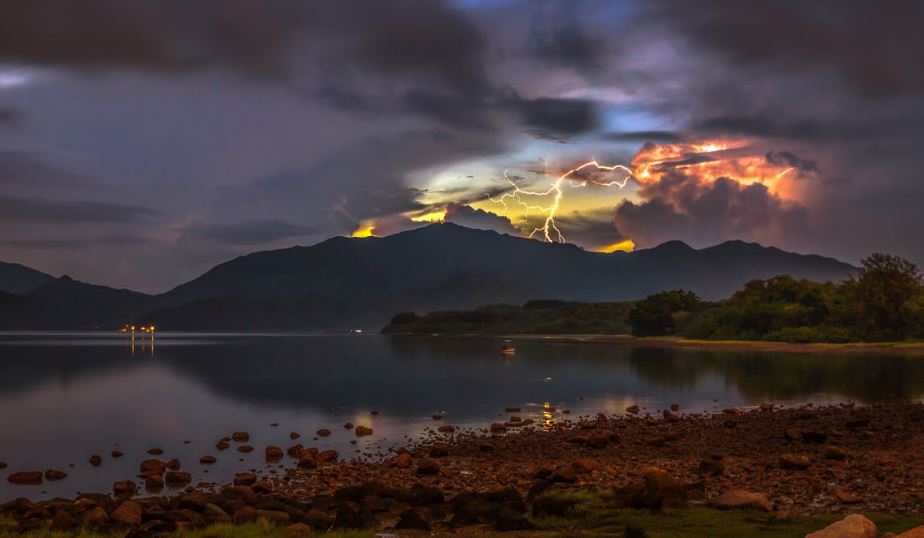Beautiful, powerful, and dangerous, lightning is one of the most fascinating forces of nature, resulting from unbalanced electric charges inside the storm clouds or between them and on Earth. Often seen as a white flash, it’s available in a spectrum of colors like red, yellow, orange, and violet, with the other colors frequently only imbued around the edges.
Yet, did you ever know that there’s also green lighting? In fact, some people have been fortunate enough to witness such an outstandingly rare weather occurrence, proving that Mother Nature works in creative ways.
In this article, let’s discover what causes these green lighting flashes, as well as other theories and concepts leading to this eerie yet fascinating natural phenomenon.
What is Lightning?
To fully understand things, let’s get to the basics first and understand what lightning is. Lightning is a form of electricity that comes from clouds. When the ground gets hot, the air above it gets warm and rises. This warm air contains water vapor, and as it goes up, the droplets cool and create a cloud. With its continuous ascent, the cloud builds up in size.
At the top of the clouds, water vapor turns into ice. As these small bits of ice move around, they bump with each other, and this collision creates static electrical charges in the clouds. Thus, turning the cloud into a thundercloud.
Like in a battery, the thundercloud has its positive (+) and negative (-) ends. The lighter positive charges form at the top of the cloud, while the heavier negative charges descend on the bottom of the cloud.
Eventually, the negative charges get strong enough, forcing the cloud to let out the giant electricity spark – the lightning. It hits a place with the opposite charge, like a different region in the same cloud, another cloud, or another surface like a tree, building, or the ground.
A fascinating fact: a lightning strike can reach temperatures between 18,000 to 50,000 degrees Fahrenheit or 27,000 degrees Celsius. The sun’s surface is estimated to be only 10,000 degrees Fahrenheit or 6,000 degrees Celsius, which means it’s five times hotter than the sun!
What causes the colors of lightning?
A genuine marvelous freak of nature, lightning comes in different colors that give some of the most awe-full images of light and hues in the skies. Yet, these colors don’t come randomly as there are actual reasons for beautiful variations in the lightning colors that we witness during thunderstorms.
Primarily, color variations in the lighting bolt result from variance in the temperature. The most common hue is white. It’s the hottest color of lightning, which means it has the highest temperature and is the most powerful and dangerous on the spectrum. Some lightning strikes appear in yellow or orange, implying that the lightning has a cooler temperature. The colder the bolt is, the relative color it will display towards the end of the spectrum.
Other events may also affect the color of the lightning. For example, lighting charges are often negative, taking place at the bottom of the cloud. Yet, there are instances when the severely strong thunderstorms emit intense positive lighting up, occurring high on top of the cloud.
Such strong energy ionizes the air above the cloud, accelerates charged particles, and disrupts electrical fields that produce red sprites or red lighting. They are pretty unusual, don’t last very long, and happen from far from the ground, making them harder to see.
Meanwhile, there are also rare purple or lilac-tinted flashes. They ripple when there is high-atmospheric humidity, implying that the thunderstorm carries a higher amount of precipitation. Its counterpart is yellow lightning, which denotes a higher amount of dust in the atmosphere and lower precipitation or a dry thunderstorm. However, like red lightning, purple lightning takes place higher in the Earth’s atmosphere and is hardly ever caught on camera.
What causes green lightning?
Though red and purple lightning bolts are already rare, there’s green lightning that’s even rarer. Truth to be told, there’s only one documented photograph of this type of lightning. A bright green lightning flash was photographed when the Chaiten volcano in Chile violently erupted in May 2008. Amidst the ash cloud and the dark sky, the green lightning emerges, creating a dramatic, striking sight.
So, how did it happen? Scientists deem that green lightning isn’t actually rare, in terms of occurrence. They believe that it appears in every thunderstorm. The catch is that it takes place very deep inside the thunderclouds, concealing it from human sight.
As aforementioned, clouds contain positive and negative ice crystals. Spikes in electrical current happen between the cloud’s positively and negatively charged regions. Yet, they are restrained inside the clouds and stay unnoticed. Chances are if we get to venture and view into the insides of a thundercloud, green lighting strikes would not be uncommon.
Meanwhile, the green lighting strike in the Chaiten volcano happened differently. Volcanic ash clouds’ electrical charges are found on the outside. As rock fragments are spewed into the air by the erupting volcano, they hit and spark these electrical charges. Green lighting strikes are then created with positively-charged surges being pulled to the negatively-charged regions of the clouds.
Gas excitation then does its part, with oxygen now being the prominent gas. As oxygen atoms get excited by the energy flow, they produce the green hue for the lightning bolt. It’s the same reason that gives off comet tails or the Aurora Borealis their vivid green color.
Takeaway
Indeed, lightning is an incredible natural phenomenon, zapping the skies in different colors from the most common ones and rarest types. Yet, remember that these freak bolts are extremely dangerous, which must always be cautious as you appreciate their power and beauty. Meanwhile, lightning strikes are only one of the many intriguing and beguiling events any person can witness. So, never stop discovering more about the world and space that surrounds us!



